Belt, MT Map & Demographics
Belt Map
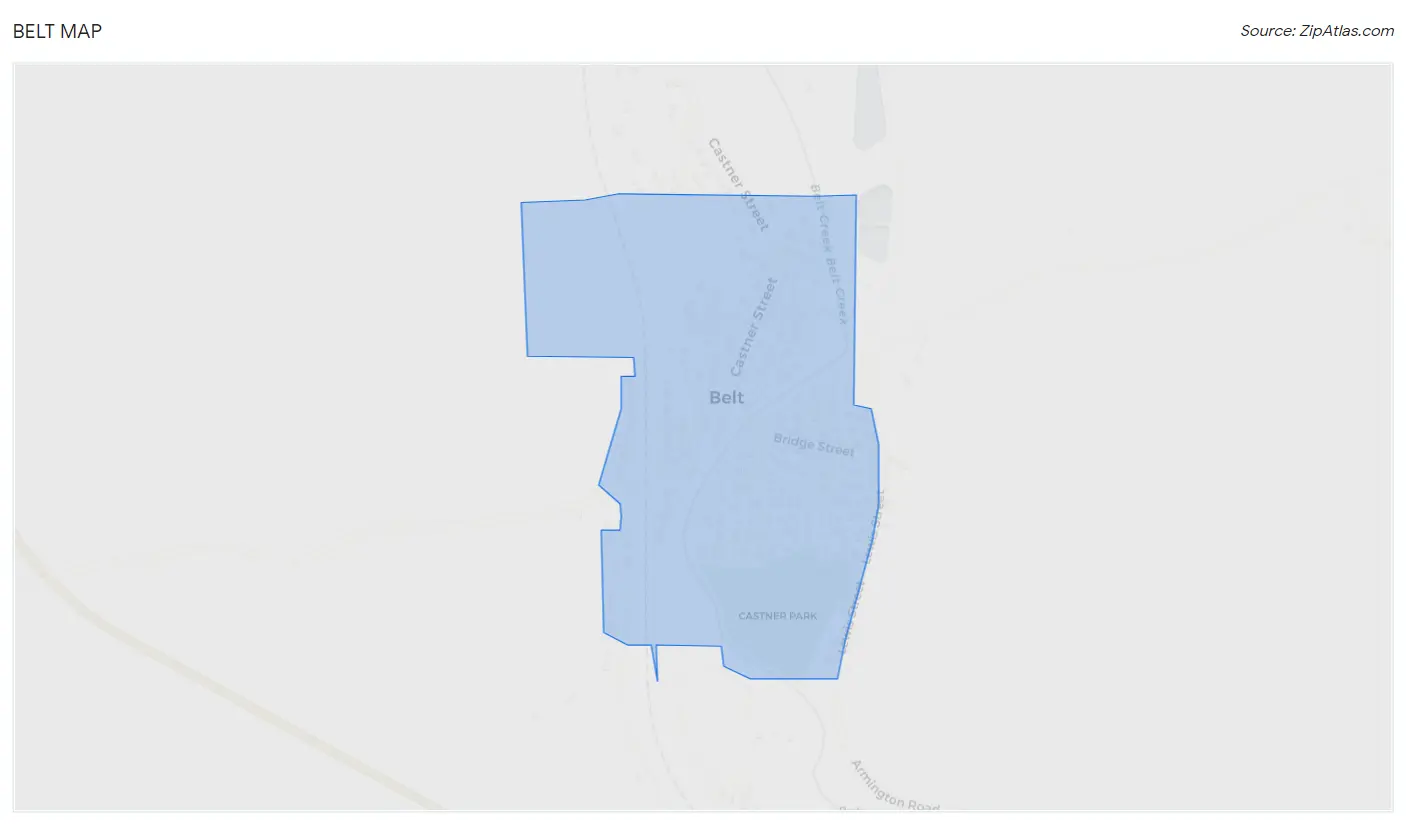
Belt Overview
$28,362
PER CAPITA INCOME
$67,857
AVG FAMILY INCOME
$65,500
AVG HOUSEHOLD INCOME
67.9%
WAGE / INCOME GAP [ % ]
32.1¢/ $1
WAGE / INCOME GAP [ $ ]
$2,571
FAMILY INCOME DEFICIT
0.39
INEQUALITY / GINI INDEX
532
TOTAL POPULATION
288
MALE POPULATION
244
FEMALE POPULATION
118.03
MALES / 100 FEMALES
84.72
FEMALES / 100 MALES
46.6
MEDIAN AGE
3.2
AVG FAMILY SIZE
2.6
AVG HOUSEHOLD SIZE
307
LABOR FORCE [ PEOPLE ]
64.9%
PERCENT IN LABOR FORCE
7.2%
UNEMPLOYMENT RATE
Belt Zip Codes
Belt Area Codes
Income in Belt
Income Overview in Belt
Per Capita Income in Belt is $28,362, while median incomes of families and households are $67,857 and $65,500 respectively.
| Characteristic | Number | Measure |
| Per Capita Income | 532 | $28,362 |
| Median Family Income | 132 | $67,857 |
| Mean Family Income | 132 | $69,134 |
| Median Household Income | 204 | $65,500 |
| Mean Household Income | 204 | $65,223 |
| Income Deficit | 132 | $2,571 |
| Wage / Income Gap (%) | 532 | 67.88% |
| Wage / Income Gap ($) | 532 | 32.12¢ per $1 |
| Gini / Inequality Index | 532 | 0.39 |
Earnings by Sex in Belt
Average Earnings in Belt are $36,250, $53,487 for men and $17,180 for women, a difference of 67.9%.

| Sex | Number | Average Earnings |
| Male | 133 (45.6%) | $53,487 |
| Female | 159 (54.4%) | $17,180 |
| Total | 292 (100.0%) | $36,250 |
Earnings by Sex by Income Bracket in Belt
The most common earnings brackets in Belt are $55,000 to $64,999 for men (34 | 25.6%) and $15,000 to $17,499 for women (43 | 27.0%).
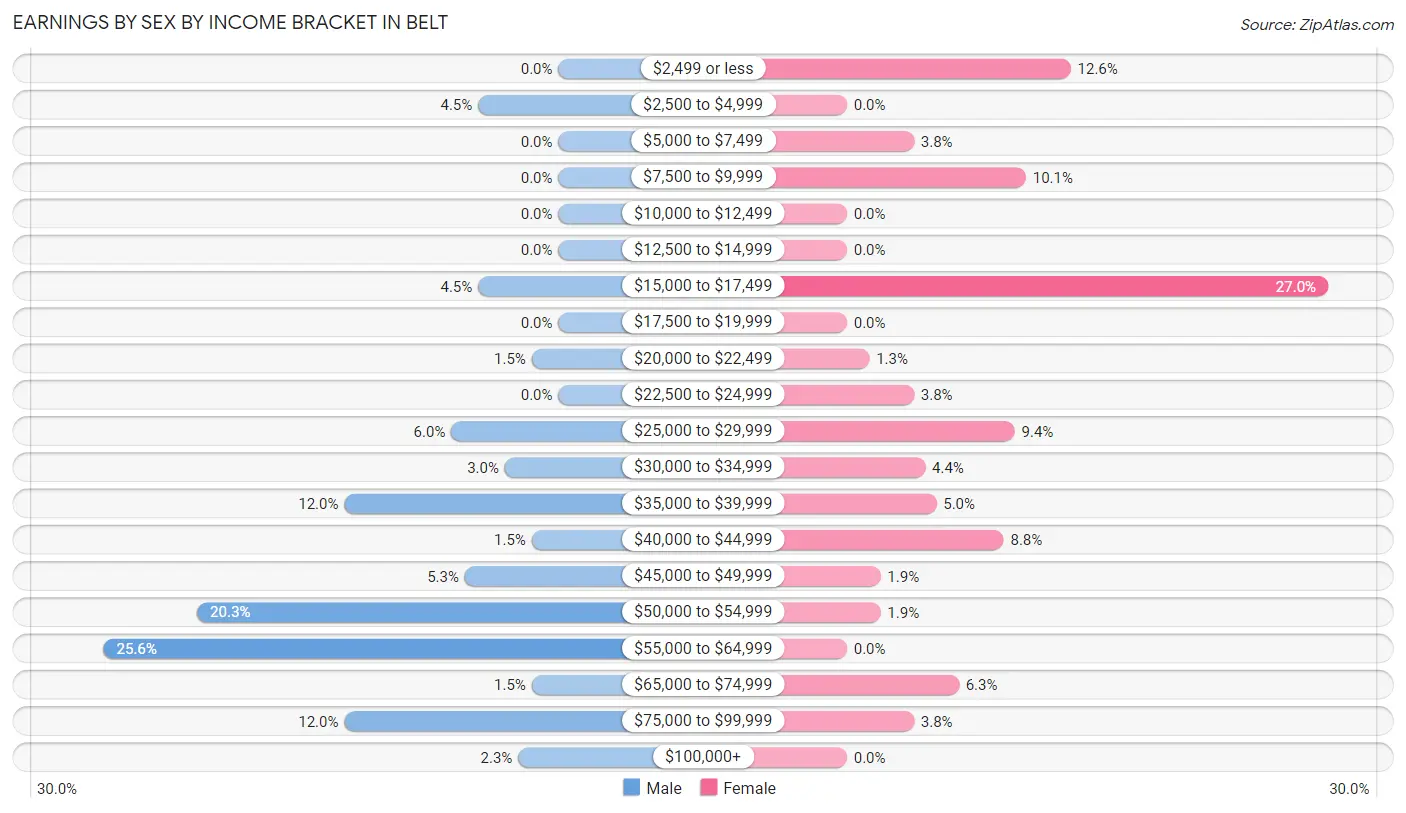
| Income | Male | Female |
| $2,499 or less | 0 (0.0%) | 20 (12.6%) |
| $2,500 to $4,999 | 6 (4.5%) | 0 (0.0%) |
| $5,000 to $7,499 | 0 (0.0%) | 6 (3.8%) |
| $7,500 to $9,999 | 0 (0.0%) | 16 (10.1%) |
| $10,000 to $12,499 | 0 (0.0%) | 0 (0.0%) |
| $12,500 to $14,999 | 0 (0.0%) | 0 (0.0%) |
| $15,000 to $17,499 | 6 (4.5%) | 43 (27.0%) |
| $17,500 to $19,999 | 0 (0.0%) | 0 (0.0%) |
| $20,000 to $22,499 | 2 (1.5%) | 2 (1.3%) |
| $22,500 to $24,999 | 0 (0.0%) | 6 (3.8%) |
| $25,000 to $29,999 | 8 (6.0%) | 15 (9.4%) |
| $30,000 to $34,999 | 4 (3.0%) | 7 (4.4%) |
| $35,000 to $39,999 | 16 (12.0%) | 8 (5.0%) |
| $40,000 to $44,999 | 2 (1.5%) | 14 (8.8%) |
| $45,000 to $49,999 | 7 (5.3%) | 3 (1.9%) |
| $50,000 to $54,999 | 27 (20.3%) | 3 (1.9%) |
| $55,000 to $64,999 | 34 (25.6%) | 0 (0.0%) |
| $65,000 to $74,999 | 2 (1.5%) | 10 (6.3%) |
| $75,000 to $99,999 | 16 (12.0%) | 6 (3.8%) |
| $100,000+ | 3 (2.3%) | 0 (0.0%) |
| Total | 133 (100.0%) | 159 (100.0%) |
Earnings by Sex by Educational Attainment in Belt
Average earnings in Belt are $50,313 for men and $20,625 for women, a difference of 59.0%. Men with an educational attainment of college or associate's degree enjoy the highest average annual earnings of $75,288, while those with high school diploma education earn the least with $36,786. Women with an educational attainment of graduate degree earn the most with the average annual earnings of $65,375, while those with college or associate's degree education have the smallest earnings of $16,599.

| Educational Attainment | Male Income | Female Income |
| Less than High School | $53,125 | $0 |
| High School Diploma | $36,786 | $0 |
| College or Associate's Degree | $75,288 | $16,599 |
| Bachelor's Degree | $58,333 | $27,143 |
| Graduate Degree | - | - |
| Total | $50,313 | $20,625 |
Family Income in Belt
Family Income Brackets in Belt
According to the Belt family income data, there are 34 families falling into the $100,000 to $149,999 income range, which is the most common income bracket and makes up 25.8% of all families.

| Income Bracket | # Families | % Families |
| Less than $10,000 | 2 | 1.5% |
| $10,000 to $14,999 | 0 | 0.0% |
| $15,000 to $24,999 | 24 | 18.2% |
| $25,000 to $34,999 | 12 | 9.1% |
| $35,000 to $49,999 | 18 | 13.6% |
| $50,000 to $74,999 | 27 | 20.5% |
| $75,000 to $99,999 | 15 | 11.4% |
| $100,000 to $149,999 | 34 | 25.8% |
| $150,000 to $199,999 | 0 | 0.0% |
| $200,000+ | 0 | 0.0% |
Family Income by Famaliy Size in Belt
4-person families (26 | 19.7%) account for the highest median family income in Belt with $137,679 per family, while 4-person families (26 | 19.7%) have the highest median income of $34,420 per family member.

| Income Bracket | # Families | Median Income |
| 2-Person Families | 78 (59.1%) | $0 |
| 3-Person Families | 24 (18.2%) | $0 |
| 4-Person Families | 26 (19.7%) | $137,679 |
| 5-Person Families | 4 (3.0%) | $0 |
| 6-Person Families | 0 (0.0%) | $0 |
| 7+ Person Families | 0 (0.0%) | $0 |
| Total | 132 (100.0%) | $67,857 |
Family Income by Number of Earners in Belt

| Number of Earners | # Families | Median Income |
| No Earners | 17 (12.9%) | $21,042 |
| 1 Earner | 64 (48.5%) | $36,500 |
| 2 Earners | 37 (28.0%) | $81,607 |
| 3+ Earners | 14 (10.6%) | $0 |
| Total | 132 (100.0%) | $67,857 |
Household Income in Belt
Household Income Brackets in Belt
With 52 households falling in the category, the $100,000 to $149,999 income range is the most frequent in Belt, accounting for 25.5% of all households.

| Income Bracket | # Households | % Households |
| Less than $10,000 | 12 | 5.9% |
| $10,000 to $14,999 | 3 | 1.5% |
| $15,000 to $24,999 | 42 | 20.6% |
| $25,000 to $34,999 | 22 | 10.8% |
| $35,000 to $49,999 | 12 | 5.9% |
| $50,000 to $74,999 | 34 | 16.7% |
| $75,000 to $99,999 | 27 | 13.2% |
| $100,000 to $149,999 | 52 | 25.5% |
| $150,000 to $199,999 | 0 | 0.0% |
| $200,000+ | 0 | 0.0% |
Household Income by Householder Age in Belt
The median household income in Belt is $65,500, with the highest median household income of $88,750 found in the 45 to 64 years age bracket for the primary householder. A total of 90 households (44.1%) fall into this category.

| Income Bracket | # Households | Median Income |
| 15 to 24 Years | 0 (0.0%) | $0 |
| 25 to 44 Years | 32 (15.7%) | $75,227 |
| 45 to 64 Years | 90 (44.1%) | $88,750 |
| 65+ Years | 82 (40.2%) | $26,563 |
| Total | 204 (100.0%) | $65,500 |
Poverty in Belt
Income Below Poverty by Sex and Age in Belt
With 14.2% poverty level for males and 9.0% for females among the residents of Belt, 18 to 24 year old males and 75 year old and over females are the most vulnerable to poverty, with 22 males (43.1%) and 8 females (29.6%) in their respective age groups living below the poverty level.
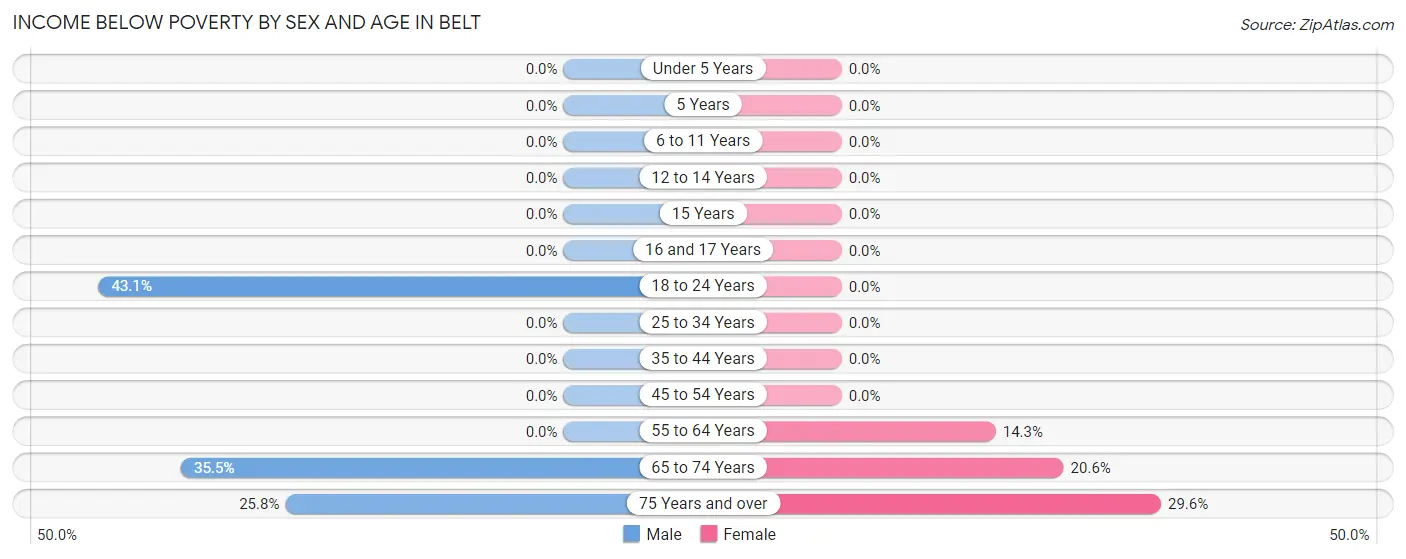
| Age Bracket | Male | Female |
| Under 5 Years | 0 (0.0%) | 0 (0.0%) |
| 5 Years | 0 (0.0%) | 0 (0.0%) |
| 6 to 11 Years | 0 (0.0%) | 0 (0.0%) |
| 12 to 14 Years | 0 (0.0%) | 0 (0.0%) |
| 15 Years | 0 (0.0%) | 0 (0.0%) |
| 16 and 17 Years | 0 (0.0%) | 0 (0.0%) |
| 18 to 24 Years | 22 (43.1%) | 0 (0.0%) |
| 25 to 34 Years | 0 (0.0%) | 0 (0.0%) |
| 35 to 44 Years | 0 (0.0%) | 0 (0.0%) |
| 45 to 54 Years | 0 (0.0%) | 0 (0.0%) |
| 55 to 64 Years | 0 (0.0%) | 7 (14.3%) |
| 65 to 74 Years | 11 (35.5%) | 7 (20.6%) |
| 75 Years and over | 8 (25.8%) | 8 (29.6%) |
| Total | 41 (14.2%) | 22 (9.0%) |
Income Above Poverty by Sex and Age in Belt
According to the poverty statistics in Belt, males aged 5 years and females aged under 5 years are the age groups that are most secure financially, with 100.0% of males and 100.0% of females in these age groups living above the poverty line.
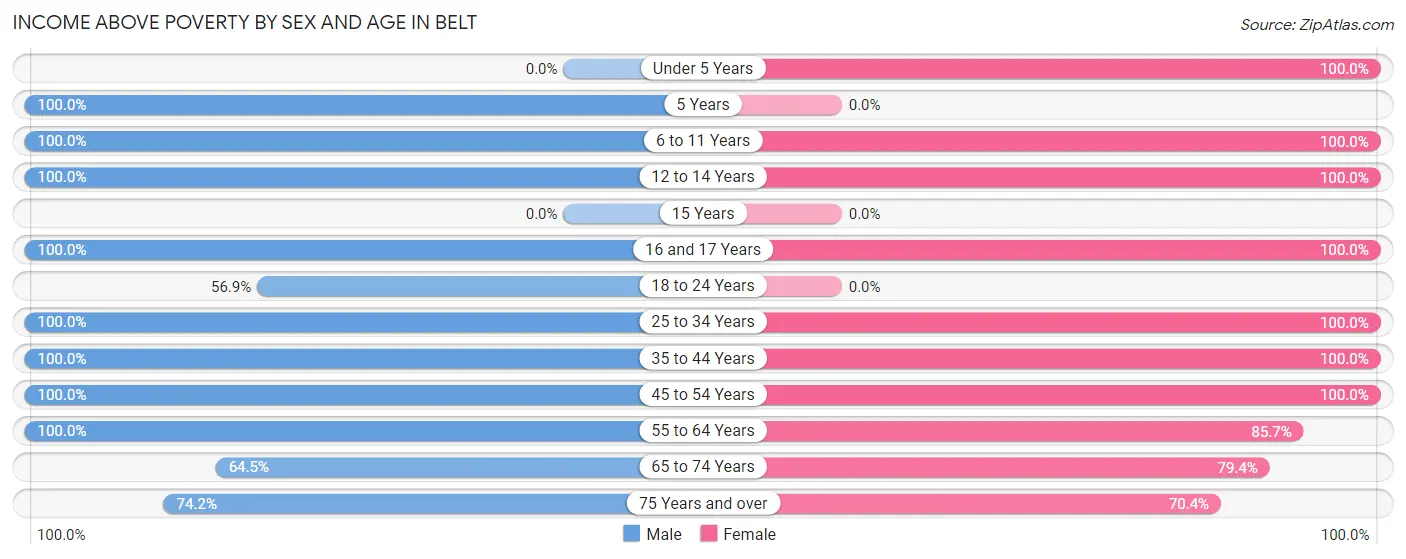
| Age Bracket | Male | Female |
| Under 5 Years | 0 (0.0%) | 4 (100.0%) |
| 5 Years | 7 (100.0%) | 0 (0.0%) |
| 6 to 11 Years | 11 (100.0%) | 3 (100.0%) |
| 12 to 14 Years | 31 (100.0%) | 3 (100.0%) |
| 15 Years | 0 (0.0%) | 0 (0.0%) |
| 16 and 17 Years | 15 (100.0%) | 12 (100.0%) |
| 18 to 24 Years | 29 (56.9%) | 0 (0.0%) |
| 25 to 34 Years | 9 (100.0%) | 28 (100.0%) |
| 35 to 44 Years | 24 (100.0%) | 55 (100.0%) |
| 45 to 54 Years | 25 (100.0%) | 29 (100.0%) |
| 55 to 64 Years | 53 (100.0%) | 42 (85.7%) |
| 65 to 74 Years | 20 (64.5%) | 27 (79.4%) |
| 75 Years and over | 23 (74.2%) | 19 (70.4%) |
| Total | 247 (85.8%) | 222 (91.0%) |
Income Below Poverty Among Married-Couple Families in Belt
The poverty statistics for married-couple families in Belt show that 16.7% or 14 of the total 84 families live below the poverty line. Families with no children have the highest poverty rate of 18.2%, comprising of 14 families. On the other hand, families with 1 or 2 children have the lowest poverty rate of 0.0%, which includes 0 families.

| Children | Above Poverty | Below Poverty |
| No Children | 63 (81.8%) | 14 (18.2%) |
| 1 or 2 Children | 3 (100.0%) | 0 (0.0%) |
| 3 or 4 Children | 4 (100.0%) | 0 (0.0%) |
| 5 or more Children | 0 (0.0%) | 0 (0.0%) |
| Total | 70 (83.3%) | 14 (16.7%) |
Income Below Poverty Among Single-Parent Households in Belt

| Children | Single Father | Single Mother |
| No Children | 0 (0.0%) | 0 (0.0%) |
| 1 or 2 Children | 0 (0.0%) | 0 (0.0%) |
| 3 or 4 Children | 0 (0.0%) | 0 (0.0%) |
| 5 or more Children | 0 (0.0%) | 0 (0.0%) |
| Total | 0 (0.0%) | 0 (0.0%) |
Income Below Poverty Among Married-Couple vs Single-Parent Households in Belt

| Children | Married-Couple Families | Single-Parent Households |
| No Children | 14 (18.2%) | 0 (0.0%) |
| 1 or 2 Children | 0 (0.0%) | 0 (0.0%) |
| 3 or 4 Children | 0 (0.0%) | 0 (0.0%) |
| 5 or more Children | 0 (0.0%) | 0 (0.0%) |
| Total | 14 (16.7%) | 0 (0.0%) |
Race in Belt
The most populous races in Belt are White / Caucasian (472 | 88.7%), Hispanic or Latino (53 | 10.0%), and Some other Race (49 | 9.2%).

| Race | # Population | % Population |
| Asian | 2 | 0.4% |
| Black / African American | 0 | 0.0% |
| Hawaiian / Pacific | 0 | 0.0% |
| Hispanic or Latino | 53 | 10.0% |
| Native / Alaskan | 0 | 0.0% |
| White / Caucasian | 472 | 88.7% |
| Two or more Races | 9 | 1.7% |
| Some other Race | 49 | 9.2% |
| Total | 532 | 100.0% |
Ancestry in Belt
The most populous ancestries reported in Belt are German (121 | 22.7%), Mexican (53 | 10.0%), Norwegian (37 | 7.0%), Polish (36 | 6.8%), and Irish (31 | 5.8%), together accounting for 52.2% of all Belt residents.
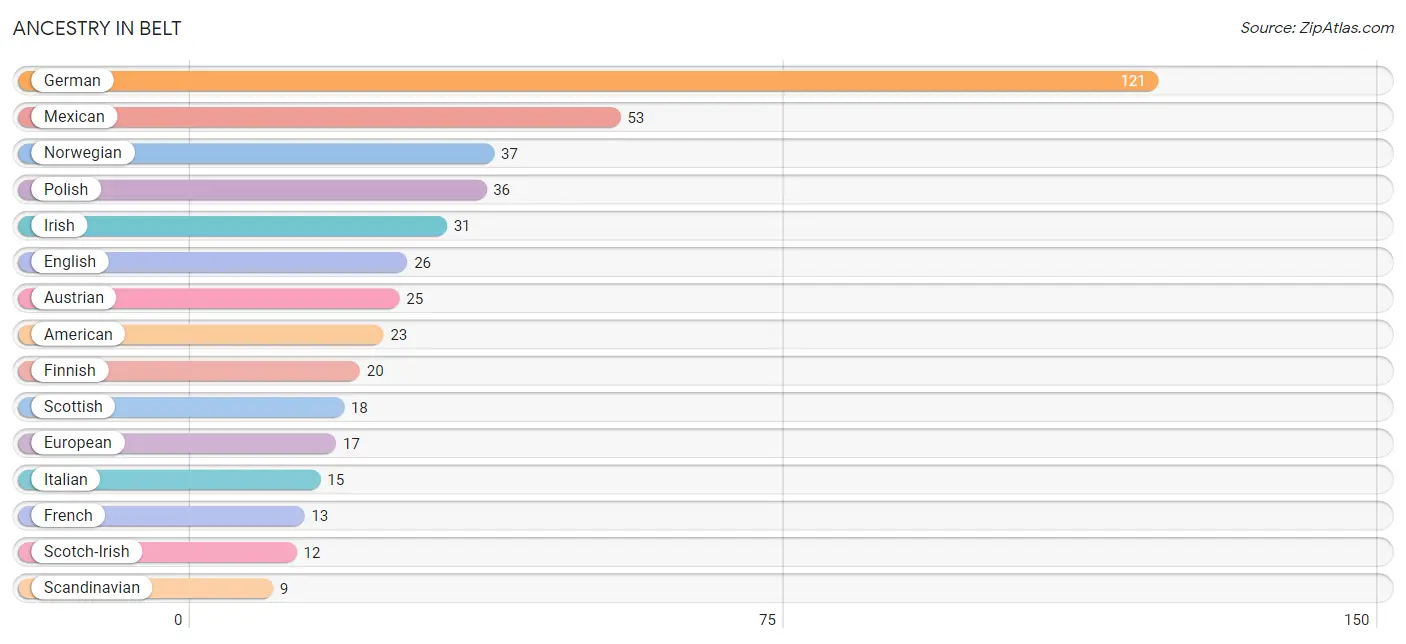
| Ancestry | # Population | % Population |
| American | 23 | 4.3% |
| Austrian | 25 | 4.7% |
| British | 6 | 1.1% |
| Burmese | 2 | 0.4% |
| Canadian | 6 | 1.1% |
| Czech | 2 | 0.4% |
| Danish | 5 | 0.9% |
| Dutch | 8 | 1.5% |
| English | 26 | 4.9% |
| European | 17 | 3.2% |
| Finnish | 20 | 3.8% |
| French | 13 | 2.4% |
| French American Indian | 3 | 0.6% |
| French Canadian | 3 | 0.6% |
| German | 121 | 22.7% |
| Irish | 31 | 5.8% |
| Italian | 15 | 2.8% |
| Mexican | 53 | 10.0% |
| Norwegian | 37 | 7.0% |
| Polish | 36 | 6.8% |
| Russian | 4 | 0.7% |
| Scandinavian | 9 | 1.7% |
| Scotch-Irish | 12 | 2.3% |
| Scottish | 18 | 3.4% |
| Swedish | 2 | 0.4% |
| Swiss | 1 | 0.2% |
| Yugoslavian | 3 | 0.6% | View All 27 Rows |
Immigrants in Belt
The most numerous immigrant groups reported in Belt came from Canada (6 | 1.1%), England (6 | 1.1%), Europe (6 | 1.1%), Northern Europe (6 | 1.1%), and Asia (2 | 0.4%), together accounting for 4.9% of all Belt residents.

| Immigration Origin | # Population | % Population |
| Asia | 2 | 0.4% |
| Canada | 6 | 1.1% |
| Eastern Asia | 2 | 0.4% |
| England | 6 | 1.1% |
| Europe | 6 | 1.1% |
| Korea | 2 | 0.4% |
| Northern Europe | 6 | 1.1% | View All 7 Rows |
Sex and Age in Belt
Sex and Age in Belt
The most populous age groups in Belt are 20 to 24 Years (51 | 17.7%) for men and 35 to 39 Years (54 | 22.1%) for women.
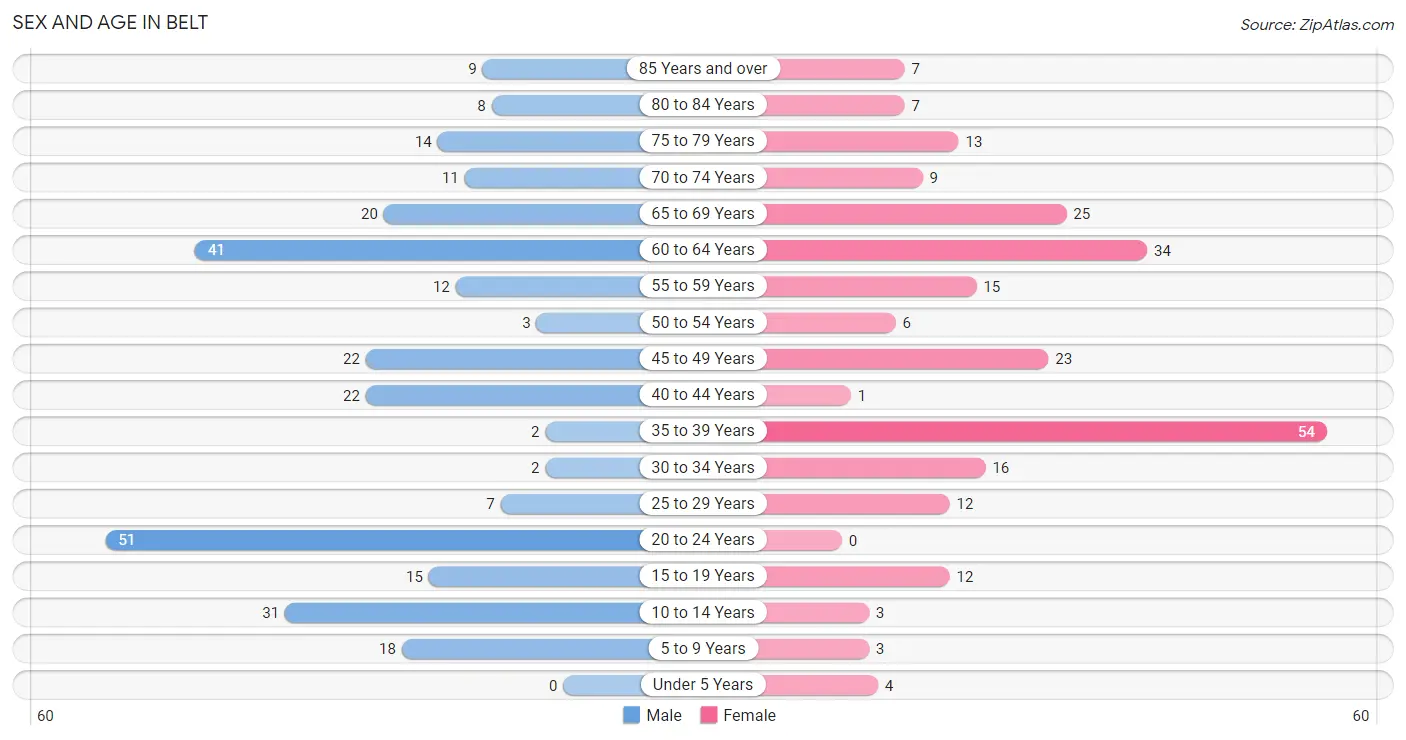
| Age Bracket | Male | Female |
| Under 5 Years | 0 (0.0%) | 4 (1.6%) |
| 5 to 9 Years | 18 (6.2%) | 3 (1.2%) |
| 10 to 14 Years | 31 (10.8%) | 3 (1.2%) |
| 15 to 19 Years | 15 (5.2%) | 12 (4.9%) |
| 20 to 24 Years | 51 (17.7%) | 0 (0.0%) |
| 25 to 29 Years | 7 (2.4%) | 12 (4.9%) |
| 30 to 34 Years | 2 (0.7%) | 16 (6.6%) |
| 35 to 39 Years | 2 (0.7%) | 54 (22.1%) |
| 40 to 44 Years | 22 (7.6%) | 1 (0.4%) |
| 45 to 49 Years | 22 (7.6%) | 23 (9.4%) |
| 50 to 54 Years | 3 (1.0%) | 6 (2.5%) |
| 55 to 59 Years | 12 (4.2%) | 15 (6.1%) |
| 60 to 64 Years | 41 (14.2%) | 34 (13.9%) |
| 65 to 69 Years | 20 (6.9%) | 25 (10.2%) |
| 70 to 74 Years | 11 (3.8%) | 9 (3.7%) |
| 75 to 79 Years | 14 (4.9%) | 13 (5.3%) |
| 80 to 84 Years | 8 (2.8%) | 7 (2.9%) |
| 85 Years and over | 9 (3.1%) | 7 (2.9%) |
| Total | 288 (100.0%) | 244 (100.0%) |
Families and Households in Belt
Median Family Size in Belt
The median family size in Belt is 3.25 persons per family, with married-couple families (84 | 63.6%) accounting for the largest median family size of 3.57 persons per family. On the other hand, single male/father families (19 | 14.4%) represent the smallest median family size with 2.21 persons per family.

| Family Type | # Families | Family Size |
| Married-Couple | 84 (63.6%) | 3.57 |
| Single Male/Father | 19 (14.4%) | 2.21 |
| Single Female/Mother | 29 (22.0%) | 3.00 |
| Total Families | 132 (100.0%) | 3.25 |
Median Household Size in Belt
The median household size in Belt is 2.61 persons per household, with married-couple households (84 | 41.2%) accounting for the largest median household size of 3.57 persons per household. non-family households (72 | 35.3%) represent the smallest median household size with 1.17 persons per household.

| Household Type | # Households | Household Size |
| Married-Couple | 84 (41.2%) | 3.57 |
| Single Male/Father | 19 (9.3%) | 2.53 |
| Single Female/Mother | 29 (14.2%) | 3.45 |
| Non-family | 72 (35.3%) | 1.17 |
| Total Households | 204 (100.0%) | 2.61 |
Household Size by Marriage Status in Belt
Out of a total of 204 households in Belt, 132 (64.7%) are family households, while 72 (35.3%) are nonfamily households. The most numerous type of family households are 2-person households, comprising 70, and the most common type of nonfamily households are 1-person households, comprising 60.

| Household Size | Family Households | Nonfamily Households |
| 1-Person Households | - | 60 (29.4%) |
| 2-Person Households | 70 (34.3%) | 12 (5.9%) |
| 3-Person Households | 22 (10.8%) | 0 (0.0%) |
| 4-Person Households | 36 (17.6%) | 0 (0.0%) |
| 5-Person Households | 4 (2.0%) | 0 (0.0%) |
| 6-Person Households | 0 (0.0%) | 0 (0.0%) |
| 7+ Person Households | 0 (0.0%) | 0 (0.0%) |
| Total | 132 (64.7%) | 72 (35.3%) |
Female Fertility in Belt
Fertility by Age in Belt

| Age Bracket | Women with Births | Births / 1,000 Women |
| 15 to 19 years | 0 (0.0%) | 0.0 |
| 20 to 34 years | 0 (0.0%) | 0.0 |
| 35 to 50 years | 0 (0.0%) | 0.0 |
| Total | 0 (0.0%) | 0.0 |
Fertility by Age by Marriage Status in Belt

| Age Bracket | Married | Unmarried |
| 15 to 19 years | 0 (0.0%) | 0 (0.0%) |
| 20 to 34 years | 0 (0.0%) | 0 (0.0%) |
| 35 to 50 years | 0 (0.0%) | 0 (0.0%) |
| Total | 0 (0.0%) | 0 (0.0%) |
Fertility by Education in Belt
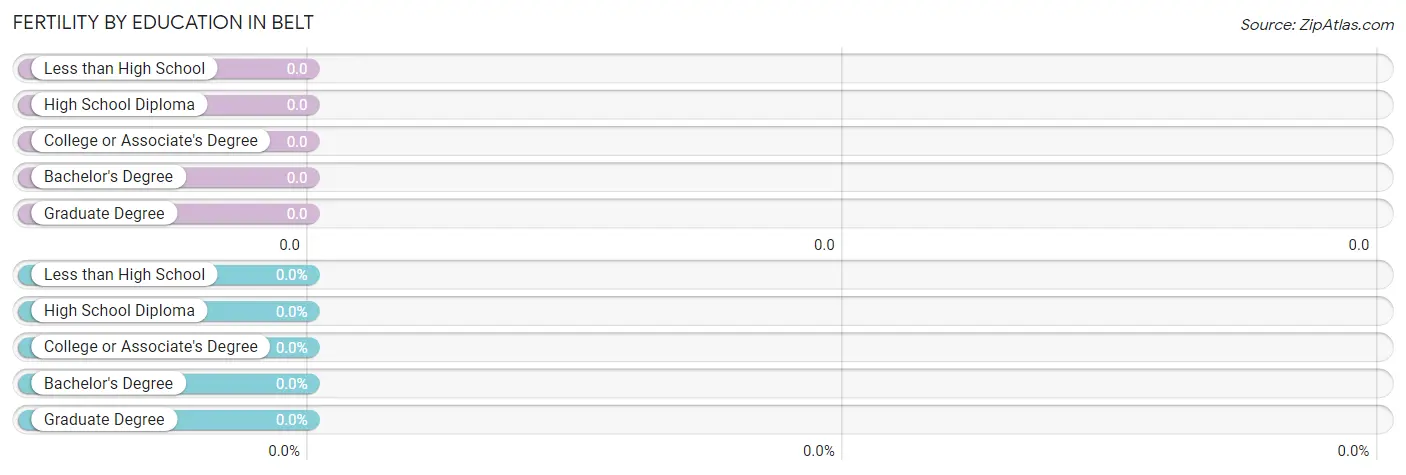
| Educational Attainment | Women with Births | Births / 1,000 Women |
| Less than High School | 0 (0.0%) | 0.0 |
| High School Diploma | 0 (0.0%) | 0.0 |
| College or Associate's Degree | 0 (0.0%) | 0.0 |
| Bachelor's Degree | 0 (0.0%) | 0.0 |
| Graduate Degree | 0 (0.0%) | 0.0 |
| Total | 0 (0.0%) | 0.0 |
Fertility by Education by Marriage Status in Belt

| Educational Attainment | Married | Unmarried |
| Less than High School | 0 (0.0%) | 0 (0.0%) |
| High School Diploma | 0 (0.0%) | 0 (0.0%) |
| College or Associate's Degree | 0 (0.0%) | 0 (0.0%) |
| Bachelor's Degree | 0 (0.0%) | 0 (0.0%) |
| Graduate Degree | 0 (0.0%) | 0 (0.0%) |
| Total | 0 (0.0%) | 0 (0.0%) |
Employment Characteristics in Belt
Employment by Class of Employer in Belt
Among the 285 employed individuals in Belt, private company employees (213 | 74.7%), local government employees (35 | 12.3%), and self-employed (not incorporated) (25 | 8.8%) make up the most common classes of employment.

| Employer Class | # Employees | % Employees |
| Private Company Employees | 213 | 74.7% |
| Self-Employed (Incorporated) | 0 | 0.0% |
| Self-Employed (Not Incorporated) | 25 | 8.8% |
| Not-for-profit Organizations | 6 | 2.1% |
| Local Government Employees | 35 | 12.3% |
| State Government Employees | 6 | 2.1% |
| Federal Government Employees | 0 | 0.0% |
| Unpaid Family Workers | 0 | 0.0% |
| Total | 285 | 100.0% |
Employment Status by Age in Belt
According to the labor force statistics for Belt, out of the total population over 16 years of age (473), 64.9% or 307 individuals are in the labor force, with 7.2% or 22 of them unemployed. The age group with the highest labor force participation rate is 20 to 24 years, with 100.0% or 51 individuals in the labor force. Within the labor force, the 20 to 24 years age range has the highest percentage of unemployed individuals, with 43.1% or 22 of them being unemployed.

| Age Bracket | In Labor Force | Unemployed |
| 16 to 19 Years | 12 (44.4%) | 0 (0.0%) |
| 20 to 24 Years | 51 (100.0%) | 22 (43.1%) |
| 25 to 29 Years | 7 (36.8%) | 0 (0.0%) |
| 30 to 34 Years | 16 (88.9%) | 0 (0.0%) |
| 35 to 44 Years | 79 (100.0%) | 0 (0.0%) |
| 45 to 54 Years | 48 (88.9%) | 0 (0.0%) |
| 55 to 59 Years | 22 (81.5%) | 0 (0.0%) |
| 60 to 64 Years | 49 (65.3%) | 0 (0.0%) |
| 65 to 74 Years | 16 (24.6%) | 0 (0.0%) |
| 75 Years and over | 7 (12.1%) | 0 (0.0%) |
| Total | 307 (64.9%) | 22 (7.2%) |
Employment Status by Educational Attainment in Belt

| Educational Attainment | In Labor Force | Unemployed |
| Less than High School | 16 (50.0%) | 0 (0.0%) |
| High School Diploma | 81 (89.0%) | 0 (0.0%) |
| College / Associate Degree | 83 (93.3%) | 0 (0.0%) |
| Bachelor's Degree or higher | 41 (68.3%) | 0 (0.0%) |
| Total | 221 (81.3%) | 0 (0.0%) |
Employment Occupations by Sex in Belt
Management, Business, Science and Arts Occupations
The most common Management, Business, Science and Arts occupations in Belt are Community & Social Service (41 | 14.4%), Education Instruction & Library (41 | 14.4%), Business & Financial (13 | 4.6%), Health Diagnosing & Treating (8 | 2.8%), and Management (4 | 1.4%).
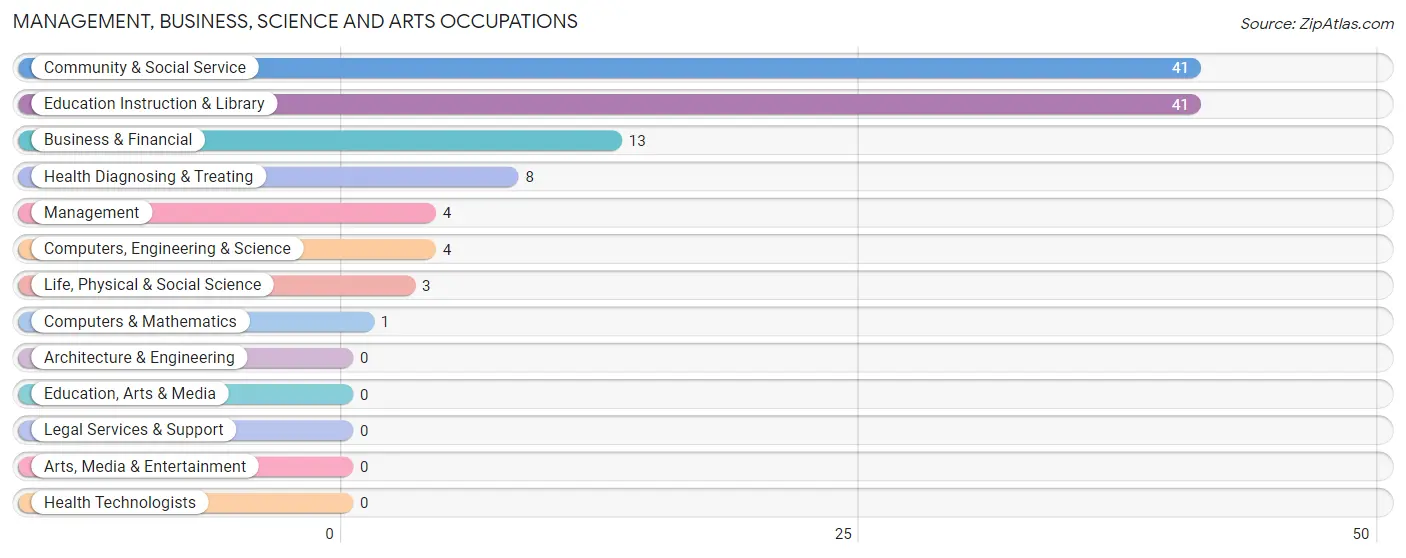
Management, Business, Science and Arts Occupations by Sex
Within the Management, Business, Science and Arts occupations in Belt, the most male-oriented occupations are Business & Financial (100.0%), Computers, Engineering & Science (100.0%), and Computers & Mathematics (100.0%), while the most female-oriented occupations are Community & Social Service (97.6%), Education Instruction & Library (97.6%), and Health Diagnosing & Treating (75.0%).
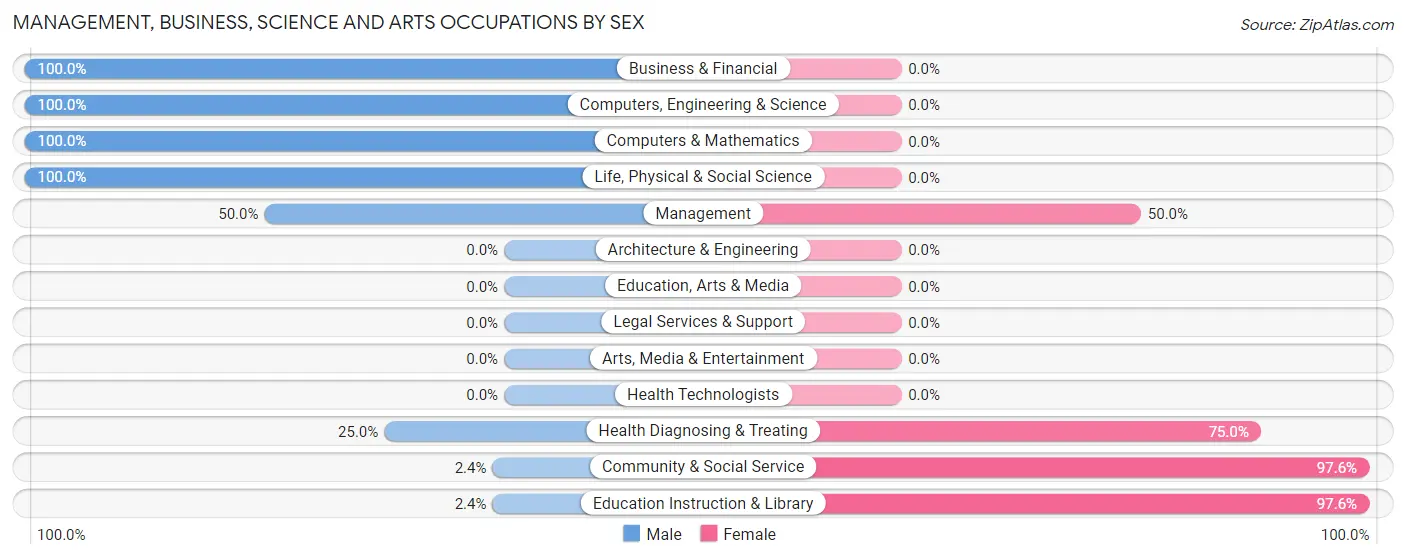
| Occupation | Male | Female |
| Management | 2 (50.0%) | 2 (50.0%) |
| Business & Financial | 13 (100.0%) | 0 (0.0%) |
| Computers, Engineering & Science | 4 (100.0%) | 0 (0.0%) |
| Computers & Mathematics | 1 (100.0%) | 0 (0.0%) |
| Architecture & Engineering | 0 (0.0%) | 0 (0.0%) |
| Life, Physical & Social Science | 3 (100.0%) | 0 (0.0%) |
| Community & Social Service | 1 (2.4%) | 40 (97.6%) |
| Education, Arts & Media | 0 (0.0%) | 0 (0.0%) |
| Legal Services & Support | 0 (0.0%) | 0 (0.0%) |
| Education Instruction & Library | 1 (2.4%) | 40 (97.6%) |
| Arts, Media & Entertainment | 0 (0.0%) | 0 (0.0%) |
| Health Diagnosing & Treating | 2 (25.0%) | 6 (75.0%) |
| Health Technologists | 0 (0.0%) | 0 (0.0%) |
| Total (Category) | 22 (31.4%) | 48 (68.6%) |
| Total (Overall) | 133 (46.7%) | 152 (53.3%) |
Services Occupations
The most common Services occupations in Belt are Healthcare Support (43 | 15.1%), Cleaning & Maintenance (29 | 10.2%), and Food Preparation & Serving (15 | 5.3%).

Services Occupations by Sex
Within the Services occupations in Belt, the most male-oriented occupations are Cleaning & Maintenance (27.6%), and Food Preparation & Serving (20.0%), while the most female-oriented occupations are Healthcare Support (100.0%), Food Preparation & Serving (80.0%), and Cleaning & Maintenance (72.4%).

| Occupation | Male | Female |
| Healthcare Support | 0 (0.0%) | 43 (100.0%) |
| Security & Protection | 0 (0.0%) | 0 (0.0%) |
| Firefighting & Prevention | 0 (0.0%) | 0 (0.0%) |
| Law Enforcement | 0 (0.0%) | 0 (0.0%) |
| Food Preparation & Serving | 3 (20.0%) | 12 (80.0%) |
| Cleaning & Maintenance | 8 (27.6%) | 21 (72.4%) |
| Personal Care & Service | 0 (0.0%) | 0 (0.0%) |
| Total (Category) | 11 (12.6%) | 76 (87.4%) |
| Total (Overall) | 133 (46.7%) | 152 (53.3%) |
Sales and Office Occupations
The most common Sales and Office occupations in Belt are Office & Administration (22 | 7.7%), and Sales & Related (10 | 3.5%).

Sales and Office Occupations by Sex

| Occupation | Male | Female |
| Sales & Related | 7 (70.0%) | 3 (30.0%) |
| Office & Administration | 6 (27.3%) | 16 (72.7%) |
| Total (Category) | 13 (40.6%) | 19 (59.4%) |
| Total (Overall) | 133 (46.7%) | 152 (53.3%) |
Natural Resources, Construction and Maintenance Occupations
The most common Natural Resources, Construction and Maintenance occupations in Belt are Construction & Extraction (26 | 9.1%), and Installation, Maintenance & Repair (18 | 6.3%).

Natural Resources, Construction and Maintenance Occupations by Sex

| Occupation | Male | Female |
| Farming, Fishing & Forestry | 0 (0.0%) | 0 (0.0%) |
| Construction & Extraction | 18 (69.2%) | 8 (30.8%) |
| Installation, Maintenance & Repair | 18 (100.0%) | 0 (0.0%) |
| Total (Category) | 36 (81.8%) | 8 (18.2%) |
| Total (Overall) | 133 (46.7%) | 152 (53.3%) |
Production, Transportation and Moving Occupations
The most common Production, Transportation and Moving occupations in Belt are Material Moving (33 | 11.6%), Transportation (12 | 4.2%), and Production (7 | 2.5%).

Production, Transportation and Moving Occupations by Sex

| Occupation | Male | Female |
| Production | 7 (100.0%) | 0 (0.0%) |
| Transportation | 11 (91.7%) | 1 (8.3%) |
| Material Moving | 33 (100.0%) | 0 (0.0%) |
| Total (Category) | 51 (98.1%) | 1 (1.9%) |
| Total (Overall) | 133 (46.7%) | 152 (53.3%) |
Employment Industries by Sex in Belt
Employment Industries in Belt
The major employment industries in Belt include Health Care & Social Assistance (61 | 21.4%), Educational Services (52 | 18.2%), Retail Trade (47 | 16.5%), Construction (28 | 9.8%), and Accommodation & Food Services (22 | 7.7%).
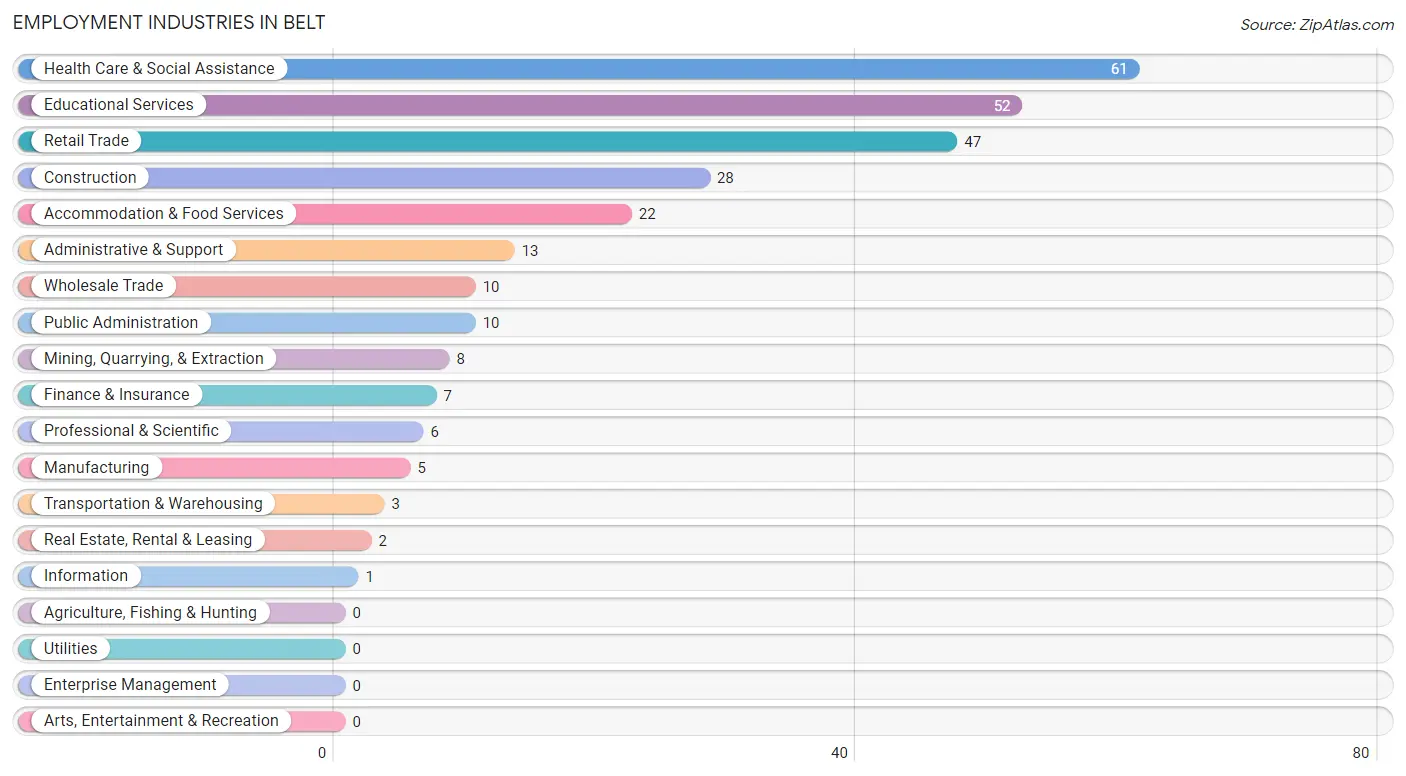
Employment Industries by Sex in Belt
The Belt industries that see more men than women are Mining, Quarrying, & Extraction (100.0%), Manufacturing (100.0%), and Wholesale Trade (100.0%), whereas the industries that tend to have a higher number of women are Transportation & Warehousing (100.0%), Finance & Insurance (100.0%), and Real Estate, Rental & Leasing (100.0%).
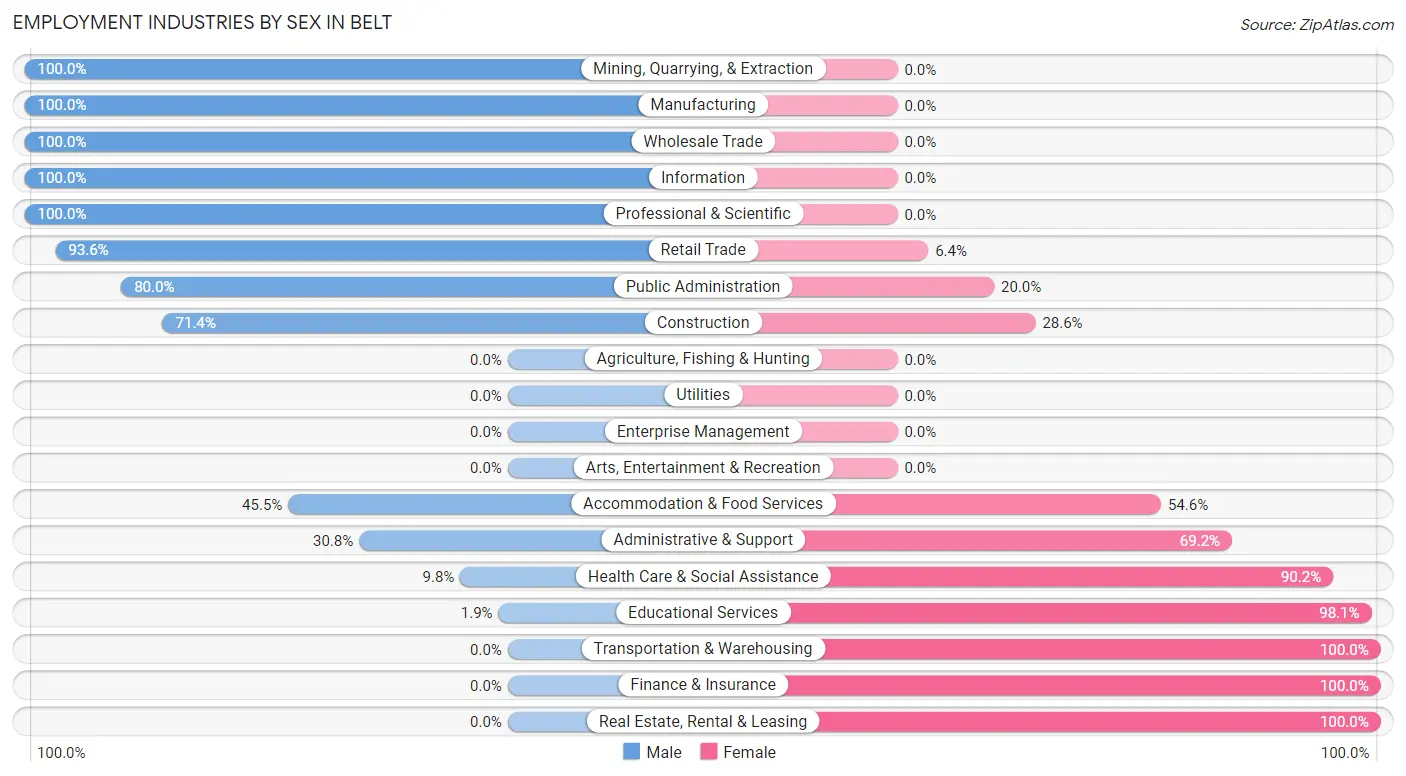
| Industry | Male | Female |
| Agriculture, Fishing & Hunting | 0 (0.0%) | 0 (0.0%) |
| Mining, Quarrying, & Extraction | 8 (100.0%) | 0 (0.0%) |
| Construction | 20 (71.4%) | 8 (28.6%) |
| Manufacturing | 5 (100.0%) | 0 (0.0%) |
| Wholesale Trade | 10 (100.0%) | 0 (0.0%) |
| Retail Trade | 44 (93.6%) | 3 (6.4%) |
| Transportation & Warehousing | 0 (0.0%) | 3 (100.0%) |
| Utilities | 0 (0.0%) | 0 (0.0%) |
| Information | 1 (100.0%) | 0 (0.0%) |
| Finance & Insurance | 0 (0.0%) | 7 (100.0%) |
| Real Estate, Rental & Leasing | 0 (0.0%) | 2 (100.0%) |
| Professional & Scientific | 6 (100.0%) | 0 (0.0%) |
| Enterprise Management | 0 (0.0%) | 0 (0.0%) |
| Administrative & Support | 4 (30.8%) | 9 (69.2%) |
| Educational Services | 1 (1.9%) | 51 (98.1%) |
| Health Care & Social Assistance | 6 (9.8%) | 55 (90.2%) |
| Arts, Entertainment & Recreation | 0 (0.0%) | 0 (0.0%) |
| Accommodation & Food Services | 10 (45.5%) | 12 (54.5%) |
| Public Administration | 8 (80.0%) | 2 (20.0%) |
| Total | 133 (46.7%) | 152 (53.3%) |
Education in Belt
School Enrollment in Belt
The most common levels of schooling among the 111 students in Belt are middle school (34 | 30.6%), high school (27 | 24.3%), and graduate / professional (24 | 21.6%).

| School Level | # Students | % Students |
| Nursery / Preschool | 9 | 8.1% |
| Kindergarten | 0 | 0.0% |
| Elementary School | 14 | 12.6% |
| Middle School | 34 | 30.6% |
| High School | 27 | 24.3% |
| College / Undergraduate | 3 | 2.7% |
| Graduate / Professional | 24 | 21.6% |
| Total | 111 | 100.0% |
School Enrollment by Age by Funding Source in Belt
Out of a total of 111 students who are enrolled in schools in Belt, 2 (1.8%) attend a private institution, while the remaining 109 (98.2%) are enrolled in public schools. The age group of 3 to 4 year olds has the highest likelihood of being enrolled in private schools, with 2 (100.0% in the age bracket) enrolled. Conversely, the age group of 5 to 9 year old has the lowest likelihood of being enrolled in a private school, with 21 (100.0% in the age bracket) attending a public institution.

| Age Bracket | Public School | Private School |
| 3 to 4 Year Olds | 0 (0.0%) | 2 (100.0%) |
| 5 to 9 Year Old | 21 (100.0%) | 0 (0.0%) |
| 10 to 14 Year Olds | 34 (100.0%) | 0 (0.0%) |
| 15 to 17 Year Olds | 27 (100.0%) | 0 (0.0%) |
| 18 to 19 Year Olds | 0 (0.0%) | 0 (0.0%) |
| 20 to 24 Year Olds | 22 (100.0%) | 0 (0.0%) |
| 25 to 34 Year Olds | 2 (100.0%) | 0 (0.0%) |
| 35 Years and over | 3 (100.0%) | 0 (0.0%) |
| Total | 109 (98.2%) | 2 (1.8%) |
Educational Attainment by Field of Study in Belt
Education (24 | 34.8%), engineering (14 | 20.3%), psychology (9 | 13.0%), arts & humanities (8 | 11.6%), and business (6 | 8.7%) are the most common fields of study among 69 individuals in Belt who have obtained a bachelor's degree or higher.
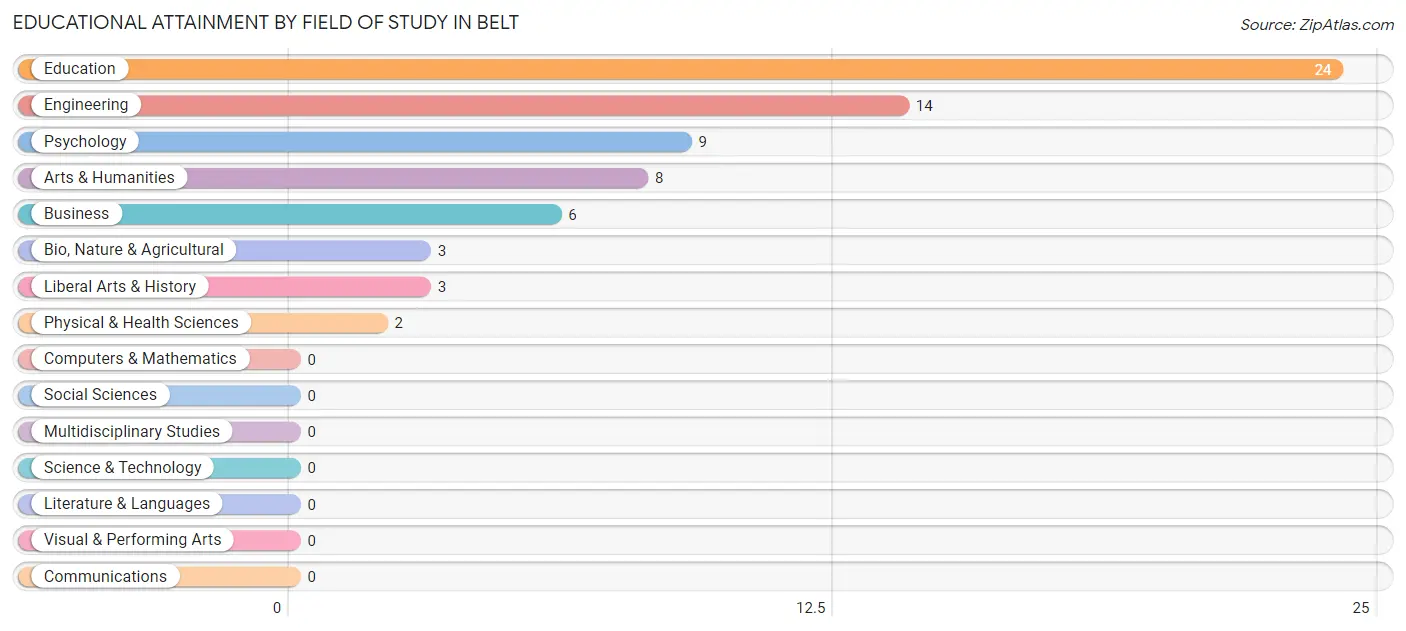
| Field of Study | # Graduates | % Graduates |
| Computers & Mathematics | 0 | 0.0% |
| Bio, Nature & Agricultural | 3 | 4.3% |
| Physical & Health Sciences | 2 | 2.9% |
| Psychology | 9 | 13.0% |
| Social Sciences | 0 | 0.0% |
| Engineering | 14 | 20.3% |
| Multidisciplinary Studies | 0 | 0.0% |
| Science & Technology | 0 | 0.0% |
| Business | 6 | 8.7% |
| Education | 24 | 34.8% |
| Literature & Languages | 0 | 0.0% |
| Liberal Arts & History | 3 | 4.3% |
| Visual & Performing Arts | 0 | 0.0% |
| Communications | 0 | 0.0% |
| Arts & Humanities | 8 | 11.6% |
| Total | 69 | 100.0% |
Transportation & Commute in Belt
Vehicle Availability by Sex in Belt
The most prevalent vehicle ownership categories in Belt are males with 3 vehicles (58, accounting for 43.6%) and females with 3 vehicles (98, making up 38.2%).

| Vehicles Available | Male | Female |
| No Vehicle | 0 (0.0%) | 0 (0.0%) |
| 1 Vehicle | 29 (21.8%) | 22 (14.5%) |
| 2 Vehicles | 36 (27.1%) | 22 (14.5%) |
| 3 Vehicles | 58 (43.6%) | 98 (64.5%) |
| 4 Vehicles | 10 (7.5%) | 10 (6.6%) |
| 5 or more Vehicles | 0 (0.0%) | 0 (0.0%) |
| Total | 133 (100.0%) | 152 (100.0%) |
Commute Time in Belt
The most frequently occuring commute durations in Belt are 30 to 34 minutes (90 commuters, 32.6%), 15 to 19 minutes (56 commuters, 20.3%), and 5 to 9 minutes (49 commuters, 17.7%).
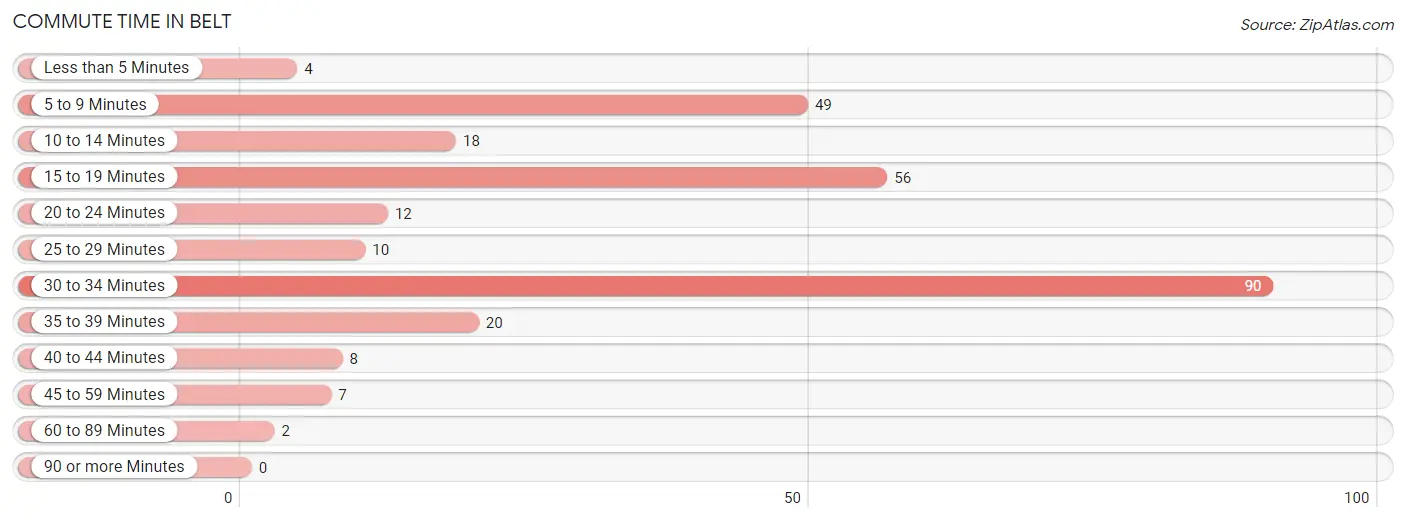
| Commute Time | # Commuters | % Commuters |
| Less than 5 Minutes | 4 | 1.5% |
| 5 to 9 Minutes | 49 | 17.7% |
| 10 to 14 Minutes | 18 | 6.5% |
| 15 to 19 Minutes | 56 | 20.3% |
| 20 to 24 Minutes | 12 | 4.3% |
| 25 to 29 Minutes | 10 | 3.6% |
| 30 to 34 Minutes | 90 | 32.6% |
| 35 to 39 Minutes | 20 | 7.2% |
| 40 to 44 Minutes | 8 | 2.9% |
| 45 to 59 Minutes | 7 | 2.5% |
| 60 to 89 Minutes | 2 | 0.7% |
| 90 or more Minutes | 0 | 0.0% |
Commute Time by Sex in Belt
The most common commute times in Belt are 30 to 34 minutes (43 commuters, 34.1%) for males and 15 to 19 minutes (50 commuters, 33.3%) for females.
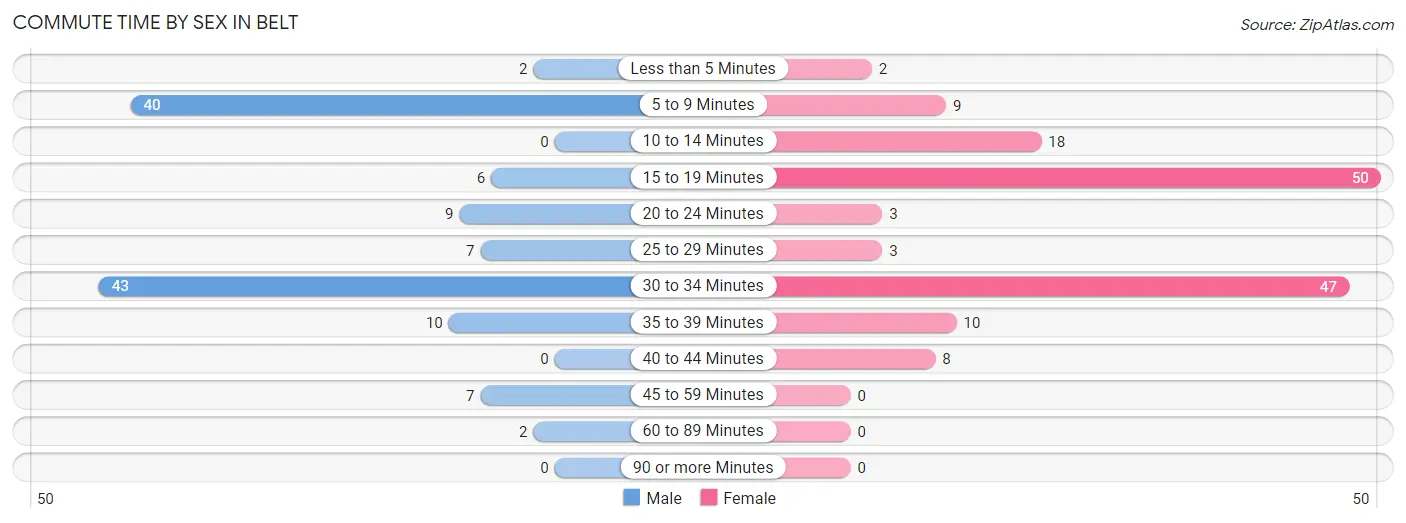
| Commute Time | Male | Female |
| Less than 5 Minutes | 2 (1.6%) | 2 (1.3%) |
| 5 to 9 Minutes | 40 (31.8%) | 9 (6.0%) |
| 10 to 14 Minutes | 0 (0.0%) | 18 (12.0%) |
| 15 to 19 Minutes | 6 (4.8%) | 50 (33.3%) |
| 20 to 24 Minutes | 9 (7.1%) | 3 (2.0%) |
| 25 to 29 Minutes | 7 (5.6%) | 3 (2.0%) |
| 30 to 34 Minutes | 43 (34.1%) | 47 (31.3%) |
| 35 to 39 Minutes | 10 (7.9%) | 10 (6.7%) |
| 40 to 44 Minutes | 0 (0.0%) | 8 (5.3%) |
| 45 to 59 Minutes | 7 (5.6%) | 0 (0.0%) |
| 60 to 89 Minutes | 2 (1.6%) | 0 (0.0%) |
| 90 or more Minutes | 0 (0.0%) | 0 (0.0%) |
Time of Departure to Work by Sex in Belt
The most frequent times of departure to work in Belt are 6:00 AM to 6:29 AM (45, 35.7%) for males and 8:00 AM to 8:29 AM (51, 34.0%) for females.
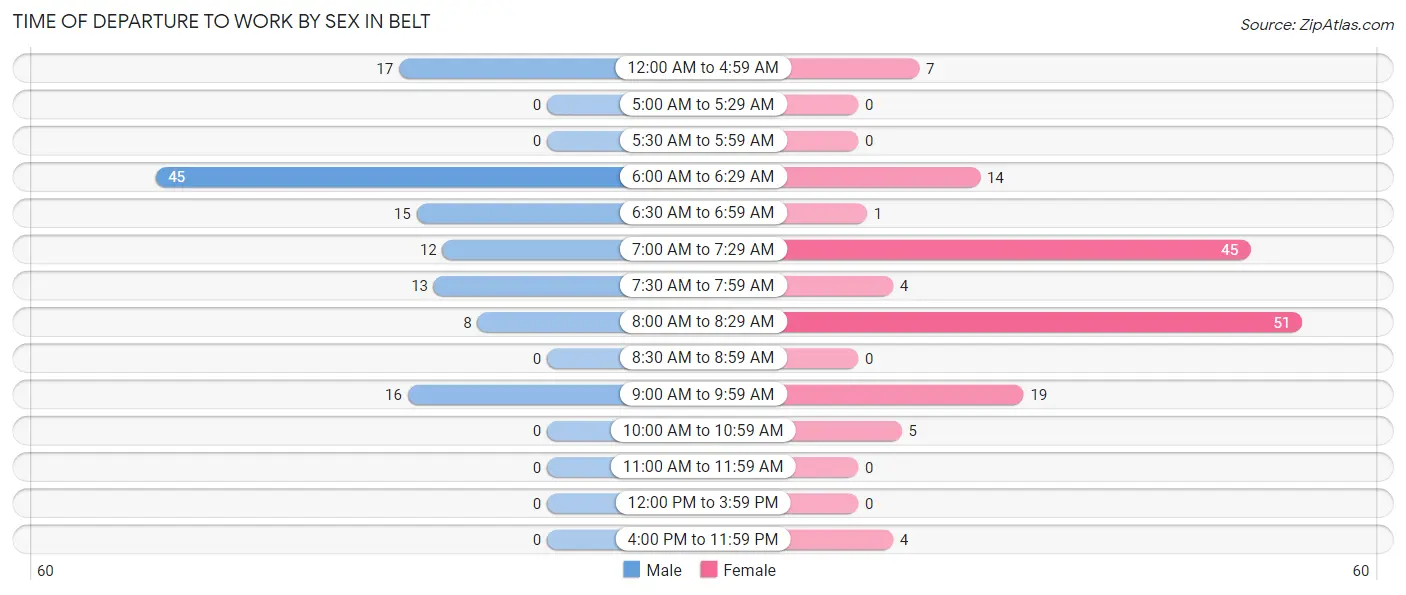
| Time of Departure | Male | Female |
| 12:00 AM to 4:59 AM | 17 (13.5%) | 7 (4.7%) |
| 5:00 AM to 5:29 AM | 0 (0.0%) | 0 (0.0%) |
| 5:30 AM to 5:59 AM | 0 (0.0%) | 0 (0.0%) |
| 6:00 AM to 6:29 AM | 45 (35.7%) | 14 (9.3%) |
| 6:30 AM to 6:59 AM | 15 (11.9%) | 1 (0.7%) |
| 7:00 AM to 7:29 AM | 12 (9.5%) | 45 (30.0%) |
| 7:30 AM to 7:59 AM | 13 (10.3%) | 4 (2.7%) |
| 8:00 AM to 8:29 AM | 8 (6.4%) | 51 (34.0%) |
| 8:30 AM to 8:59 AM | 0 (0.0%) | 0 (0.0%) |
| 9:00 AM to 9:59 AM | 16 (12.7%) | 19 (12.7%) |
| 10:00 AM to 10:59 AM | 0 (0.0%) | 5 (3.3%) |
| 11:00 AM to 11:59 AM | 0 (0.0%) | 0 (0.0%) |
| 12:00 PM to 3:59 PM | 0 (0.0%) | 0 (0.0%) |
| 4:00 PM to 11:59 PM | 0 (0.0%) | 4 (2.7%) |
| Total | 126 (100.0%) | 150 (100.0%) |
Housing Occupancy in Belt
Occupancy by Ownership in Belt
Of the total 204 dwellings in Belt, owner-occupied units account for 147 (72.1%), while renter-occupied units make up 57 (27.9%).

| Occupancy | # Housing Units | % Housing Units |
| Owner Occupied Housing Units | 147 | 72.1% |
| Renter-Occupied Housing Units | 57 | 27.9% |
| Total Occupied Housing Units | 204 | 100.0% |
Occupancy by Household Size in Belt

| Household Size | # Housing Units | % Housing Units |
| 1-Person Household | 60 | 29.4% |
| 2-Person Household | 82 | 40.2% |
| 3-Person Household | 22 | 10.8% |
| 4+ Person Household | 40 | 19.6% |
| Total Housing Units | 204 | 100.0% |
Occupancy by Ownership by Household Size in Belt

| Household Size | Owner-occupied | Renter-occupied |
| 1-Person Household | 30 (50.0%) | 30 (50.0%) |
| 2-Person Household | 70 (85.4%) | 12 (14.6%) |
| 3-Person Household | 10 (45.5%) | 12 (54.5%) |
| 4+ Person Household | 37 (92.5%) | 3 (7.5%) |
| Total Housing Units | 147 (72.1%) | 57 (27.9%) |
Occupancy by Educational Attainment in Belt

| Household Size | Owner-occupied | Renter-occupied |
| Less than High School | 12 (63.2%) | 7 (36.8%) |
| High School Diploma | 45 (69.2%) | 20 (30.8%) |
| College/Associate Degree | 51 (70.8%) | 21 (29.2%) |
| Bachelor's Degree or higher | 39 (81.2%) | 9 (18.8%) |
Occupancy by Age of Householder in Belt

| Age Bracket | # Households | % Households |
| Under 35 Years | 13 | 6.4% |
| 35 to 44 Years | 19 | 9.3% |
| 45 to 54 Years | 29 | 14.2% |
| 55 to 64 Years | 61 | 29.9% |
| 65 to 74 Years | 44 | 21.6% |
| 75 to 84 Years | 29 | 14.2% |
| 85 Years and Over | 9 | 4.4% |
| Total | 204 | 100.0% |
Housing Finances in Belt
Median Income by Occupancy in Belt

| Occupancy Type | # Households | Median Income |
| Owner-Occupied | 147 (72.1%) | $74,844 |
| Renter-Occupied | 57 (27.9%) | $26,607 |
| Average | 204 (100.0%) | $65,500 |
Occupancy by Householder Income Bracket in Belt
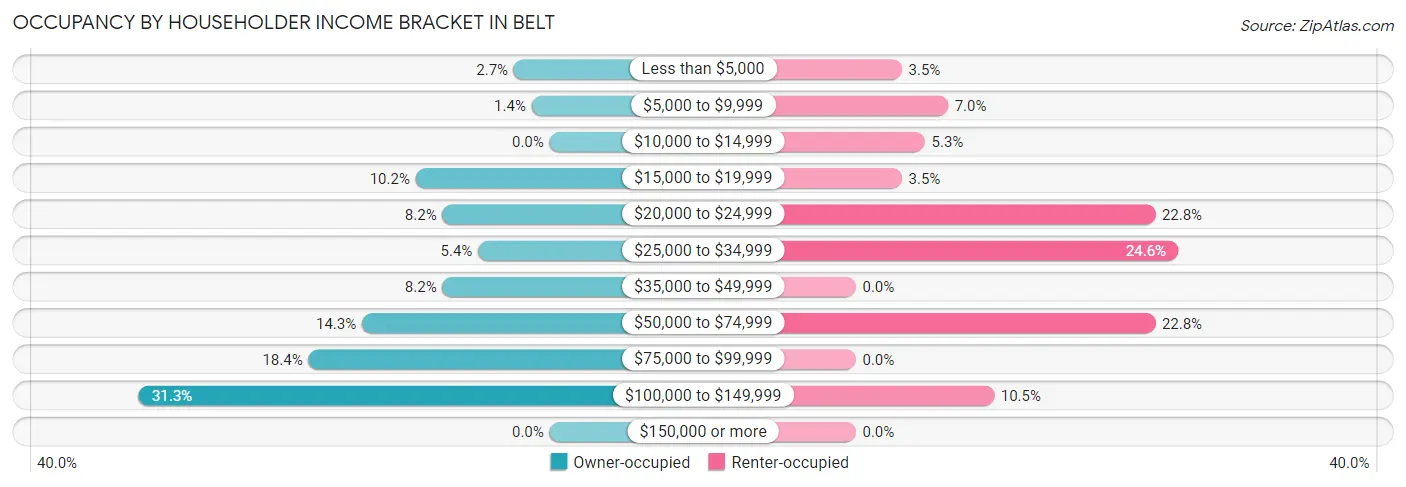
| Income Bracket | Owner-occupied | Renter-occupied |
| Less than $5,000 | 4 (2.7%) | 2 (3.5%) |
| $5,000 to $9,999 | 2 (1.4%) | 4 (7.0%) |
| $10,000 to $14,999 | 0 (0.0%) | 3 (5.3%) |
| $15,000 to $19,999 | 15 (10.2%) | 2 (3.5%) |
| $20,000 to $24,999 | 12 (8.2%) | 13 (22.8%) |
| $25,000 to $34,999 | 8 (5.4%) | 14 (24.6%) |
| $35,000 to $49,999 | 12 (8.2%) | 0 (0.0%) |
| $50,000 to $74,999 | 21 (14.3%) | 13 (22.8%) |
| $75,000 to $99,999 | 27 (18.4%) | 0 (0.0%) |
| $100,000 to $149,999 | 46 (31.3%) | 6 (10.5%) |
| $150,000 or more | 0 (0.0%) | 0 (0.0%) |
| Total | 147 (100.0%) | 57 (100.0%) |
Monthly Housing Cost Tiers in Belt

| Monthly Cost | Owner-occupied | Renter-occupied |
| Less than $300 | 9 (6.1%) | 14 (24.6%) |
| $300 to $499 | 23 (15.7%) | 2 (3.5%) |
| $500 to $799 | 33 (22.5%) | 20 (35.1%) |
| $800 to $999 | 45 (30.6%) | 12 (21.0%) |
| $1,000 to $1,499 | 17 (11.6%) | 0 (0.0%) |
| $1,500 to $1,999 | 20 (13.6%) | 6 (10.5%) |
| $2,000 to $2,499 | 0 (0.0%) | 3 (5.3%) |
| $2,500 to $2,999 | 0 (0.0%) | 0 (0.0%) |
| $3,000 or more | 0 (0.0%) | 0 (0.0%) |
| Total | 147 (100.0%) | 57 (100.0%) |
Physical Housing Characteristics in Belt
Housing Structures in Belt

| Structure Type | # Housing Units | % Housing Units |
| Single Unit, Detached | 122 | 59.8% |
| Single Unit, Attached | 0 | 0.0% |
| 2 Unit Apartments | 2 | 1.0% |
| 3 or 4 Unit Apartments | 24 | 11.8% |
| 5 to 9 Unit Apartments | 5 | 2.5% |
| 10 or more Apartments | 0 | 0.0% |
| Mobile Home / Other | 51 | 25.0% |
| Total | 204 | 100.0% |
Housing Structures by Occupancy in Belt

| Structure Type | Owner-occupied | Renter-occupied |
| Single Unit, Detached | 102 (83.6%) | 20 (16.4%) |
| Single Unit, Attached | 0 (0.0%) | 0 (0.0%) |
| 2 Unit Apartments | 0 (0.0%) | 2 (100.0%) |
| 3 or 4 Unit Apartments | 0 (0.0%) | 24 (100.0%) |
| 5 to 9 Unit Apartments | 0 (0.0%) | 5 (100.0%) |
| 10 or more Apartments | 0 (0.0%) | 0 (0.0%) |
| Mobile Home / Other | 45 (88.2%) | 6 (11.8%) |
| Total | 147 (72.1%) | 57 (27.9%) |
Housing Structures by Number of Rooms in Belt

| Number of Rooms | Owner-occupied | Renter-occupied |
| 1 Room | 0 (0.0%) | 0 (0.0%) |
| 2 or 3 Rooms | 0 (0.0%) | 12 (21.0%) |
| 4 or 5 Rooms | 54 (36.7%) | 35 (61.4%) |
| 6 or 7 Rooms | 63 (42.9%) | 10 (17.5%) |
| 8 or more Rooms | 30 (20.4%) | 0 (0.0%) |
| Total | 147 (100.0%) | 57 (100.0%) |
Housing Structure by Heating Type in Belt

| Heating Type | Owner-occupied | Renter-occupied |
| Utility Gas | 2 (1.4%) | 0 (0.0%) |
| Bottled, Tank, or LP Gas | 80 (54.4%) | 18 (31.6%) |
| Electricity | 15 (10.2%) | 31 (54.4%) |
| Fuel Oil or Kerosene | 14 (9.5%) | 8 (14.0%) |
| Coal or Coke | 0 (0.0%) | 0 (0.0%) |
| All other Fuels | 36 (24.5%) | 0 (0.0%) |
| No Fuel Used | 0 (0.0%) | 0 (0.0%) |
| Total | 147 (100.0%) | 57 (100.0%) |
Household Vehicle Usage in Belt

| Vehicles per Household | Owner-occupied | Renter-occupied |
| No Vehicle | 8 (5.4%) | 5 (8.8%) |
| 1 Vehicle | 40 (27.2%) | 40 (70.2%) |
| 2 Vehicles | 48 (32.7%) | 0 (0.0%) |
| 3 or more Vehicles | 51 (34.7%) | 12 (21.0%) |
| Total | 147 (100.0%) | 57 (100.0%) |
Real Estate & Mortgages in Belt
Real Estate and Mortgage Overview in Belt
| Characteristic | Without Mortgage | With Mortgage |
| Housing Units | 79 | 68 |
| Median Property Value | $105,800 | $182,500 |
| Median Household Income | - | - |
| Monthly Housing Costs | $539 | $0 |
| Real Estate Taxes | $746 | $0 |
Property Value by Mortgage Status in Belt

| Property Value | Without Mortgage | With Mortgage |
| Less than $50,000 | 14 (17.7%) | 8 (11.8%) |
| $50,000 to $99,999 | 22 (27.9%) | 6 (8.8%) |
| $100,000 to $299,999 | 43 (54.4%) | 54 (79.4%) |
| $300,000 to $499,999 | 0 (0.0%) | 0 (0.0%) |
| $500,000 to $749,999 | 0 (0.0%) | 0 (0.0%) |
| $750,000 to $999,999 | 0 (0.0%) | 0 (0.0%) |
| $1,000,000 or more | 0 (0.0%) | 0 (0.0%) |
| Total | 79 (100.0%) | 68 (100.0%) |
Household Income by Mortgage Status in Belt

| Household Income | Without Mortgage | With Mortgage |
| Less than $10,000 | 6 (7.6%) | 0 (0.0%) |
| $10,000 to $24,999 | 21 (26.6%) | 0 (0.0%) |
| $25,000 to $34,999 | 8 (10.1%) | 6 (8.8%) |
| $35,000 to $49,999 | 4 (5.1%) | 0 (0.0%) |
| $50,000 to $74,999 | 19 (24.0%) | 8 (11.8%) |
| $75,000 to $99,999 | 5 (6.3%) | 2 (2.9%) |
| $100,000 to $149,999 | 16 (20.3%) | 22 (32.4%) |
| $150,000 or more | 0 (0.0%) | 30 (44.1%) |
| Total | 79 (100.0%) | 68 (100.0%) |
Property Value to Household Income Ratio in Belt

| Value-to-Income Ratio | Without Mortgage | With Mortgage |
| Less than 2.0x | 41 (51.9%) | 86,250 (126,838.2%) |
| 2.0x to 2.9x | 6 (7.6%) | 46 (67.6%) |
| 3.0x to 3.9x | 15 (19.0%) | 14 (20.6%) |
| 4.0x or more | 15 (19.0%) | 2 (2.9%) |
| Total | 79 (100.0%) | 68 (100.0%) |
Real Estate Taxes by Mortgage Status in Belt

| Property Taxes | Without Mortgage | With Mortgage |
| Less than $800 | 43 (54.4%) | 0 (0.0%) |
| $800 to $1,499 | 18 (22.8%) | 17 (25.0%) |
| $800 to $1,499 | 18 (22.8%) | 22 (32.4%) |
| Total | 79 (100.0%) | 68 (100.0%) |
Health & Disability in Belt
Health Insurance Coverage by Age in Belt

| Age Bracket | With Coverage | Without Coverage |
| Under 6 Years | 11 (100.0%) | 0 (0.0%) |
| 6 to 18 Years | 75 (100.0%) | 0 (0.0%) |
| 19 to 25 Years | 58 (100.0%) | 0 (0.0%) |
| 26 to 34 Years | 18 (60.0%) | 12 (40.0%) |
| 35 to 44 Years | 79 (100.0%) | 0 (0.0%) |
| 45 to 54 Years | 54 (100.0%) | 0 (0.0%) |
| 55 to 64 Years | 102 (100.0%) | 0 (0.0%) |
| 65 to 74 Years | 65 (100.0%) | 0 (0.0%) |
| 75 Years and older | 58 (100.0%) | 0 (0.0%) |
| Total | 520 (97.7%) | 12 (2.3%) |
Health Insurance Coverage by Citizenship Status in Belt

| Citizenship Status | With Coverage | Without Coverage |
| Native Born | 11 (100.0%) | 0 (0.0%) |
| Foreign Born, Citizen | 75 (100.0%) | 0 (0.0%) |
| Foreign Born, not a Citizen | 58 (100.0%) | 0 (0.0%) |
Health Insurance Coverage by Household Income in Belt

| Household Income | With Coverage | Without Coverage |
| Under $25,000 | 96 (88.9%) | 12 (11.1%) |
| $25,000 to $49,999 | 71 (100.0%) | 0 (0.0%) |
| $50,000 to $74,999 | 65 (100.0%) | 0 (0.0%) |
| $75,000 to $99,999 | 66 (100.0%) | 0 (0.0%) |
| $100,000 and over | 222 (100.0%) | 0 (0.0%) |
Public vs Private Health Insurance Coverage by Age in Belt

| Age Bracket | Public Insurance | Private Insurance |
| Under 6 | 7 (63.6%) | 4 (36.4%) |
| 6 to 18 Years | 48 (64.0%) | 36 (48.0%) |
| 19 to 25 Years | 7 (12.1%) | 51 (87.9%) |
| 25 to 34 Years | 2 (6.7%) | 16 (53.3%) |
| 35 to 44 Years | 2 (2.5%) | 79 (100.0%) |
| 45 to 54 Years | 13 (24.1%) | 41 (75.9%) |
| 55 to 64 Years | 37 (36.3%) | 87 (85.3%) |
| 65 to 74 Years | 65 (100.0%) | 27 (41.5%) |
| 75 Years and over | 58 (100.0%) | 44 (75.9%) |
| Total | 239 (44.9%) | 385 (72.4%) |
Disability Status by Sex by Age in Belt

| Age Bracket | Male | Female |
| Under 5 Years | 0 (0.0%) | 0 (0.0%) |
| 5 to 17 Years | 4 (6.2%) | 0 (0.0%) |
| 18 to 34 Years | 22 (36.7%) | 0 (0.0%) |
| 35 to 64 Years | 2 (2.0%) | 22 (16.5%) |
| 65 to 74 Years | 20 (64.5%) | 7 (20.6%) |
| 75 Years and over | 5 (16.1%) | 20 (74.1%) |
Disability Class by Sex by Age in Belt
Disability Class: Hearing Difficulty

| Age Bracket | Male | Female |
| Under 5 Years | 0 (0.0%) | 0 (0.0%) |
| 5 to 17 Years | 0 (0.0%) | 0 (0.0%) |
| 18 to 34 Years | 0 (0.0%) | 0 (0.0%) |
| 35 to 64 Years | 2 (2.0%) | 0 (0.0%) |
| 65 to 74 Years | 2 (6.5%) | 2 (5.9%) |
| 75 Years and over | 5 (16.1%) | 0 (0.0%) |
Disability Class: Vision Difficulty

| Age Bracket | Male | Female |
| Under 5 Years | 0 (0.0%) | 0 (0.0%) |
| 5 to 17 Years | 0 (0.0%) | 0 (0.0%) |
| 18 to 34 Years | 0 (0.0%) | 0 (0.0%) |
| 35 to 64 Years | 0 (0.0%) | 0 (0.0%) |
| 65 to 74 Years | 0 (0.0%) | 2 (5.9%) |
| 75 Years and over | 0 (0.0%) | 0 (0.0%) |
Disability Class: Cognitive Difficulty

| Age Bracket | Male | Female |
| 5 to 17 Years | 4 (6.2%) | 0 (0.0%) |
| 18 to 34 Years | 22 (36.7%) | 0 (0.0%) |
| 35 to 64 Years | 0 (0.0%) | 0 (0.0%) |
| 65 to 74 Years | 6 (19.4%) | 5 (14.7%) |
| 75 Years and over | 0 (0.0%) | 7 (25.9%) |
Disability Class: Ambulatory Difficulty

| Age Bracket | Male | Female |
| 5 to 17 Years | 0 (0.0%) | 0 (0.0%) |
| 18 to 34 Years | 0 (0.0%) | 0 (0.0%) |
| 35 to 64 Years | 0 (0.0%) | 15 (11.3%) |
| 65 to 74 Years | 13 (41.9%) | 3 (8.8%) |
| 75 Years and over | 2 (6.5%) | 20 (74.1%) |
Disability Class: Self-Care Difficulty

| Age Bracket | Male | Female |
| 5 to 17 Years | 0 (0.0%) | 0 (0.0%) |
| 18 to 34 Years | 0 (0.0%) | 0 (0.0%) |
| 35 to 64 Years | 0 (0.0%) | 6 (4.5%) |
| 65 to 74 Years | 2 (6.5%) | 0 (0.0%) |
| 75 Years and over | 0 (0.0%) | 20 (74.1%) |
Technology Access in Belt
Computing Device Access in Belt

| Device Type | # Households | % Households |
| Desktop or Laptop | 128 | 62.7% |
| Smartphone | 150 | 73.5% |
| Tablet | 95 | 46.6% |
| No Computing Device | 28 | 13.7% |
| Total | 204 | 100.0% |
Internet Access in Belt

| Internet Type | # Households | % Households |
| Dial-Up Internet | 0 | 0.0% |
| Broadband Home | 121 | 59.3% |
| Cellular Data Only | 18 | 8.8% |
| Satellite Internet | 6 | 2.9% |
| No Internet | 60 | 29.4% |
| Total | 204 | 100.0% |
Belt Summary
Belt is a small town located in Cascade County, Montana, United States. It is situated along the Rocky Mountain Front, approximately 20 miles east of Great Falls. The town was founded in 1883 and was named after the nearby Belt Mountains. As of the 2010 census, the population of Belt was 876.
Geography
Belt is located at 47°25'25" North, 111°25'25" West (47.423, -111.423). It is situated along the Rocky Mountain Front, approximately 20 miles east of Great Falls. The town is located in the Belt Valley, which is surrounded by the Belt Mountains to the north and the Little Belt Mountains to the south. The Belt Valley is a major agricultural area, with the town of Belt at its center.
Climate
Belt has a semi-arid climate, with cold winters and hot summers. The average annual temperature is 44.3°F (6.8°C). The average annual precipitation is 13.3 inches (33.8 cm).
Demographics
As of the 2010 census, the population of Belt was 876. The racial makeup of the town was 97.2% White, 0.2% African American, 0.7% Native American, 0.2% Asian, 0.2% from other races, and 1.7% from two or more races. Hispanic or Latino of any race were 1.2% of the population.
Economy
Belt is a small, rural town with a primarily agricultural economy. The town is home to several small businesses, including a grocery store, a hardware store, a restaurant, and a gas station. The town is also home to a number of farms, which produce a variety of crops, including wheat, barley, oats, hay, and alfalfa.
The town is also home to a number of small manufacturing businesses, including a woodworking shop, a metal fabrication shop, and a machine shop. The town is also home to a number of small service businesses, including a barber shop, a beauty salon, and a car repair shop.
Education
Belt is served by the Belt School District, which operates one elementary school, one middle school, and one high school. The district also operates a number of alternative education programs, including a home school program and a virtual school program.
Conclusion
Belt is a small, rural town located in Cascade County, Montana. It is situated along the Rocky Mountain Front, approximately 20 miles east of Great Falls. The town was founded in 1883 and was named after the nearby Belt Mountains. As of the 2010 census, the population of Belt was 876. The town has a semi-arid climate, with cold winters and hot summers. The town has a primarily agricultural economy, with a number of small businesses and farms. The town is served by the Belt School District, which operates one elementary school, one middle school, and one high school.
Common Questions
What is Per Capita Income in Belt?
Per Capita income in Belt is $28,362.
What is the Median Family Income in Belt?
Median Family Income in Belt is $67,857.
What is the Median Household income in Belt?
Median Household Income in Belt is $65,500.
What is Income or Wage Gap in Belt?
Income or Wage Gap in Belt is 67.9%.
Women in Belt earn 32.1 cents for every dollar earned by a man.
What is Family Income Deficit in Belt?
Family Income Deficit in Belt is $2,571.
Families that are below poverty line in Belt earn $2,571 less on average than the poverty threshold level.
What is Inequality or Gini Index in Belt?
Inequality or Gini Index in Belt is 0.39.
What is the Total Population of Belt?
Total Population of Belt is 532.
What is the Total Male Population of Belt?
Total Male Population of Belt is 288.
What is the Total Female Population of Belt?
Total Female Population of Belt is 244.
What is the Ratio of Males per 100 Females in Belt?
There are 118.03 Males per 100 Females in Belt.
What is the Ratio of Females per 100 Males in Belt?
There are 84.72 Females per 100 Males in Belt.
What is the Median Population Age in Belt?
Median Population Age in Belt is 46.6 Years.
What is the Average Family Size in Belt
Average Family Size in Belt is 3.2 People.
What is the Average Household Size in Belt
Average Household Size in Belt is 2.6 People.
How Large is the Labor Force in Belt?
There are 307 People in the Labor Forcein in Belt.
What is the Percentage of People in the Labor Force in Belt?
64.9% of People are in the Labor Force in Belt.
What is the Unemployment Rate in Belt?
Unemployment Rate in Belt is 7.2%.